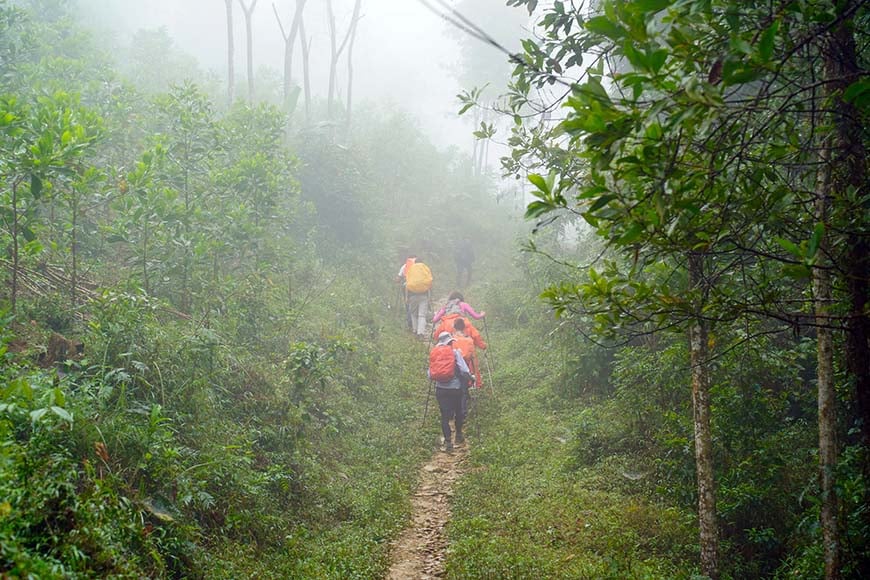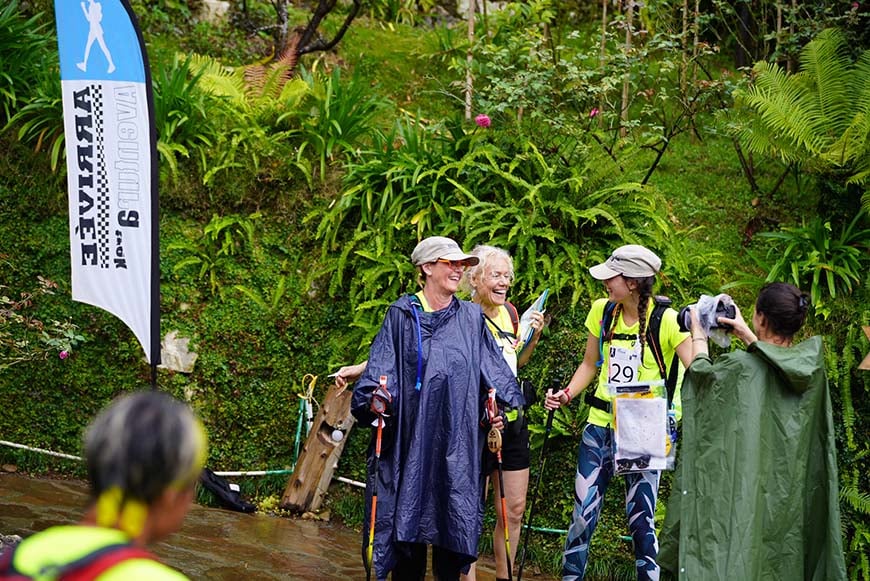Imagine yourself in the heart of northern Vietnam, in the midst of an adventure, when a typhoon changes course and threatens your trek. What does your guide do at this critical moment? Panic? Give up?
Not at all.
It is in these decisive moments that you realize the importance of the
ISO 3021 standard—the benchmark for safety in adventure tourism. Your guide will never respond with "we'll see" in the face of danger; instead, they immediately trigger their
Anti-Panic Plan, a rigorous and proven protocol that is the true guarantee of your safety.
Today, we're giving you a look behind the scenes to show you how this professional organization transforms the potential chaos of a crisis into a controlled operation, in four crucial steps.
 In the mountains, the weather is capricious | Mr Linh's Adventures
In the mountains, the weather is capricious | Mr Linh's AdventuresThe obsession with predictable danger
A professional guide doesn't discover dangers along the way: they have already anticipated and cataloged all of them. Before you even pack your bag, the trekking company has performed a documented risk analysis and assessment—an obligation under the ISO standard.
Concretely, this means mapping all critical scenarios: floods, landslides, or sudden changes due to altitude.
Take the example of Northern Vietnam. The threat of typhoons and sudden floods is a known risk. The guide doesn't search Google at the last minute; their "Anti-Panic Plan" already includes a dedicated section: "What to do if a typhoon forces an evacuation of the trekking area?" They have already identified alternative routes and safe refuge points.
This is the secret of a good guide: they have already envisioned the worst to be ready to manage the present.
 The art of anticipating trail conditions | Mr Linh's Adventures
The art of anticipating trail conditions | Mr Linh's AdventuresThe art of flexibility
Risk is never static; it constantly evolves with the weather, the condition of the trails, and the group's fatigue. That's why ISO requires a dynamic and adaptable management approach, never a fixed one.
Every morning, your guide doesn't just check that you've put on your shoes. They conduct a regular, daily assessment of the conditions: the morale and health of the participants, the latest weather forecasts, and the feasibility of the trails ahead.
This is where professionalism is expressed in the event of an imminent typhoon. The guide doesn't just stop. They implement Risk Treatment: they activate the alternative route, modifying the plan to move you away from the danger (for instance, abandoning a flood-prone valley for higher ground) while still ensuring a quality experience.
The annual test
This is the most reassuring, yet most invisible, requirement of the standard. A certified guide does not merely rely on a documented Emergency Plan in a binder.
ISO mandates that all critical procedures (evacuation, communication with emergency services, management of a serious accident) be tested at least once a year, and that personnel are trained in their application.
When your guide manages an incident calmly and efficiently on the trail, it's not luck or a flash of genius. It's the application of a protocol they have tirelessly rehearsed. They know exactly how to alert rescue services, secure a victim, and take care of the rest of the group, because they have trained to do it under pressure. Your guide is, without knowing it, a regular participant in their own crisis simulation.
 Even on a day trip, share your planned itinerary | Mr Linh's Adventures
Even on a day trip, share your planned itinerary | Mr Linh's AdventuresThe logbook
Safety isn't just about equipment; it is constant learning, a continuous improvement only possible through data traceability. Even minor incidents serve to strengthen future adventures.
The standard requires a rigorous system for recording incidents and accidents, detailing the date, location, probable causes, and the treatment applied. Why this obsession with detail? So that past mistakes are not repeated. If a group slipped on a certain passage after the rain last year, that information is recorded. This year's guide will know that they absolutely must secure that spot or bypass it in wet weather.
The guide is you! Your self-reliance checklist
The ISO 3021 standard is dedicated to professionals, but it contains an essential message: in the mountains, your safety belongs to you first and foremost. Even the best guide cannot walk for you.
To become a truly "informed traveler," here is a checklist of your individual responsibility before and during every outing:
1. The Three 'P's (Pre-departure prep)
Predict the weather: Don't rely solely on a mobile app. Always consult specialized weather bulletins for the exact region of your trek (including altitude, wind, and precipitation).
Pledge to notify others: Even for a day trip, communicate your planned itinerary, starting point, estimated return time, and the identity of your companions to a trusted person.
Provision for water and food: Don't rely on refuges or uncertain water sources. Always plan for an emergency surplus of food and water.
2. The transparency contract
Play openly: Be totally honest about your condition: fatigue, doubts, or pain. On a trek, silence is the greatest risk.
Proper gear management: Ensure your own equipment is in good condition (laced boots, dry clothes, functional flashlight). The guide is responsible for their gear; you are responsible for yours.
3. On-route observation (While walking)
Protocol knowledge: If you are walking in a group, know who the leader is and who the "sweeper" is (the assistant closing the march). Always stay visible to one or the other.
Perceive the terrain: Don't walk with your head down. If you see an unstable rock or a change in trail markers, report it. Anticipating danger is everyone's business.
 Enjoy your trek experience with a light heart and complete confidence | Mr Linh's Adventures
Enjoy your trek experience with a light heart and complete confidence | Mr Linh's AdventuresTravel with peace of mind
Becoming a responsible hiker doesn't mean you have to become a guide. It means accepting to share the mental load of safety, thus transforming your adventure into a calmer and more controlled experience.
Far from being a complication, the ISO 3021 standard is the solidest safeguard for adventure. Knowing that your guide has a revised Anti-Panic Plan, constantly adapts the itinerary based on forecasts, and is trained for the most difficult scenarios, you have only one thing left to do: enjoy the beauty of the world, with a light heart and complete confidence.